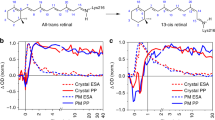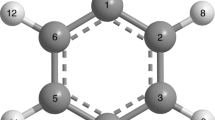Abstract
The metal-ligand complex, [Ru(2,2′-bipyridine)2(4,4′-dicarboxy-2,2′-bipyridine)]2+ (RuBDc), was used as a spectroscopic probe for studying macromolecular dynamics. RuBDc is a very photostable probe that possesses favorable photophysical properties including long lifetime, high quantum yield, large Stokes’ shift, and highly polarized emission. To further show the usefulness of this luminophore for probing macromolecular dynamics, we examined the intensity and anisotropy decays of RuBDc when conjugated to R17 bacteriophage using frequency-domain fluorometry with a blue light-emitting diode (LED) as the modulated light source. The intensity decays were best fit by a sum of two exponentials, and we obtained a longer mean lifetime at 4 °C (<τ> = 491.8 ns) as compared to that at 25 °C (<τ> = 435.1 ns). The anisotropy decay data showed a single rotational correlation time, which is typical for a spherical molecule, and the results showed a longer rotational correlation time at 4 °C (2,574.9 ns) than at 25 °C (2,070.1 ns). The use of RuBDc enabled us to measure the rotational correlation time up to several microseconds. These results indicate that RuBDc has significant potential for studying hydrodynamics of biological macromolecules.




Similar content being viewed by others
References
Lakowicz JR, Gryczynski I, Piszczek G, Tolosa L, Nair R, Johnson ML, Nowaczyk K (2000) Microsecond dynamics of biological molecules. Methods Enzymol 323:473–509
Terpetschnig E, Szmacinski H, Lakowicz JR (1997) Long-lifetime metal-ligand complexes as probes in biophysics and clinical chemistry. Methods Enzymol 278:295–321
Piszczek G (2006) Luminescent metal-ligand complexes as probes of macromolecular interactions and biopolymer dynamics. Arch Biochem Biophys 453:54–62
Castellano FN, Dattelbaum JD, Lakowicz JR (1998) Long-lifetime Ru(II) complexes as labeling reagents for sulfhydryl groups. Anal Biochem 255:165–170
Guo X-Q, Castellano FN, Li L, Szmacinski H, Lakowicz JR, Sipior J (1997) A long-lived, highly luminescent Re(I) metal-ligand complex as a biomolecular probe. Anal Biochem 254:179–186
Murtaza Z, Herman P, Lakowicz JR (1999) Synthesis and spectral characterization of a long-lifetime osmium(II) metal-ligand complex: a conjugatable red dye for applications in biophysics. Biophys Chem 80:143–151
Szmacinski H, Terpetschnig E, Lakowicz JR (1996) Synthesis and evaluation of Ru-complexes as anisotropy probes for protein hydrodynamics and immunoassays of high-molecular-weight antigens. Biophys Chem 62:109–120
Szmacinski H, Castellano FN, Terpetschnig E, Dattelbaum JD, Lakowicz JR, Meyer GJ (1998) Long-lifetime Ru(II) complexes for the measurement of high molecular weight protein hydrodynamics. Biochim Biophys Acta 1383:151–159
Terpetschnig E, Szmacinski H, Malak H, Lakowicz JR (1995) Metal-ligand complexes as a new class of long-lived fluorophores for protein hydrodynamics. Biophys J 68:342–350
Terpetschnig E, Dattelbaum JD, Szmacinski H, Lakowicz JR (1997) Synthesis and spectral characterization of a thiol-reactive long-lifetime Ru(II) complex. Anal Biochem 251:241–245
Kang JS, Piszczek G, Lakowicz JR (2002) High-molecular-weight protein hydrodynamics studied with a long-lifetime metal-ligand complex. Biochim Biophys Acta 1597:221–228
Guo X-Q, Castellano FN, Li L, Lakowicz JR (1998) A long-lifetime Ru(II) metal-ligand complex as a membrane probe. Biophys Chem 71:51–62
Li L, Szmacinski H, Lakowicz JR (1997) Synthesis and luminescence spectral characterization of long-lifetime lipid metal-ligand probes. Anal Biochem 244:80–85
Li L, Castellano FN, Gryczynski I, Lakowicz JR (1999) Long-lifetime lipid rhenium metal-ligand complex for probing membrane dynamics on the microsecond timescale. Chem Phys Lipids 99:1–9
Lakowicz JR, Malak H, Gryczynski I, Castellano FN, Meyer GJ (1995) DNA dynamics observed with long lifetime metal-ligand complexes. Biospectroscopy 1:163–168
Malak H, Gryczynski I, Lakowicz JR, Meyers GJ, Castellano FN (1997) Long-lifetime metal-ligand complexes as luminescent probes for DNA. J Fluoresc 7:107–112
Kang JS, Abugo OO, Lakowicz JR (2002) Dynamics of supercoiled and linear pTZ18U plasmids observed with a long-lifetime metal-ligand complex. Biopolymers 67:121–128
Kang JS, Abugo OO, Lakowicz JR (2002) Dynamics of supercoiled and relaxed pTZ18U plasmids probed with a long-lifetime metal-ligand complex. J Biochem Mol Biol 35:389–394
Kang JS, Son BW, Choi HD, Yoon JH, Son WS (2005) Dynamics of supercoiled and linear pBluscript II SK(+) phagemids probed with a long-lifetime metal-ligand complex. J Biochem Mol Biol 38:104–110
Haugen GR, Lytle FE (1981) Quantitation of fluorophores in solution by pulsed laser excitation of time-filtered detection. Anal Chem 53:1554–1559
Boedtker H, Gesteland RF (1975) Physical properties of RNA bacteriophages and their RNA. In: Zinder ND (ed) RNA phages. Cold Spring Harbor Laboratory, New York, pp 1–28
Gesteland RF, Boedtker H (1964) Some physical properties of bacteriophage R17 and its ribonucleic acid. J Mol Biol 8:496–507
Camerini-Otero RD, Franklin RM, Day LA (1974) Molecular weights, dispersion of refractive index increments, and dimensions from transmittance spectrophotometry. Bacteriophages R17, T7, and PM2, and tobacco mosaic virus. Biochemistry 13:3763–3773
Camerini-Otero RD, Pusey PN, Koppel DE, Schaefer DW, Franklin RM (1974) Intensity fluctuation spectroscopy of laser light scattered by solutions of spherical viruses: R17, Qβ BSV, PM2, and T7. II. Diffusion coefficients, molecular weights, solvation, and particle dimensions. Biochemistry 13:960–970
Enger MD, Stubbs EA, Mitra S, Kaesberg P (1963) Biophysical characteristics of the RNA-containing bacterial virus R17. Proc Natl Acad Sci U S A 49:857–860
Sipior J, Carter JM, Lakowicz JR, Rao G (1996) Single quantum well light-emitting diodes demonstrated as excitation sources for nanosecond phase modulation fluorescence lifetime measurements. Rev Sci Instr 67:3795–3798
Kolakofsky D (1971) Preparation of coliphage RNA. Methods Mol Biol 1:267–277
Valegård K, Unge T, Montelius I, Strandberg B (1986) Purification, crystallization and preliminary X-ray data of the bacteriophage MS2. J Mol Biol 190:587–591
Weber K, Konigsberg W (1975) Proteins of the RNA phages. In: Zinder ND (ed) RNA phages. Cold Spring Harbor Laboratory, New York, pp 51–84
Gratton E, Limkeman M, Lakowicz JR, Maliwal BP, Cherek H, Laczko G (1984) Resolution of mixtures of fluorophores using variable-frequency phase and modulation data. Biophys J 46:479–486
Lakowicz JR, Laczko G, Cherek H, Gratton E, Limkeman M (1984) Analysis of fluorescence decay kinetics from variable-frequency phase-shift and modulation data. Biophys J 46:463–477
Lakowicz JR, Gryczinski I (1991) Frequency-domain fluorescence spectroscopy. In: Lakowicz JR (ed) Topics in fluorescence spectroscopy, volume 1: techniques. Plenum, New York, pp 293–355
Lakowicz JR, Cherek H, Kusba J, Gryczinski I, Johnson ML (1993) Review of fluorescence anisotropy decay analysis by frequency-domain fluorescence spectroscopy. J Fluoresc 3:103–116
Vasquez C, Granboulan N, Franklin RM (1966) Structure of the ribonucleic acid bacteriophage R17. J Bacteriol 92:1779–1786
Zipper P, Kratky O (1971) An X-ray small angle study of the bacteriophages fr and R17. Eur J Biochem 18:1–9
Fischbach FA, Harrison PM, Anderegg JW (1965) An X-ray scattering study of the bacterial virus R17. J Mol Biol 13:638–645
Lakowicz JR (2006) Principles of fluorescence spectroscopy, 3rd edn. Springer, New York, p 367
Franklin RM, Granboulan N (1966) Ultrastructure of Escherichia coli cells infected with bacteriophage R17. J Bacteriol 91:834–848
Acknowledgments
This research was supported for two years by Pusan National University Research Grant.
Author information
Authors and Affiliations
Corresponding author
Rights and permissions
About this article
Cite this article
Kim, M.S., Kim, J.H., Son, B.W. et al. Dynamics of Bacteriophage R17 Probed with a Long-Lifetime Ru(II) Metal-Ligand Complex. J Fluoresc 20, 713–718 (2010). https://doi.org/10.1007/s10895-010-0612-6
Received:
Accepted:
Published:
Issue Date:
DOI: https://doi.org/10.1007/s10895-010-0612-6




